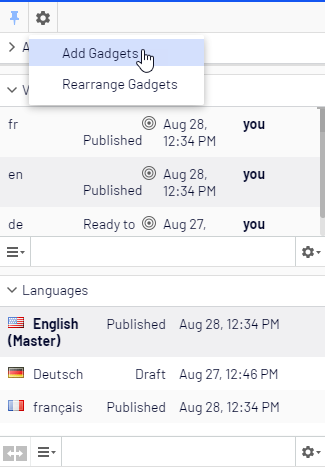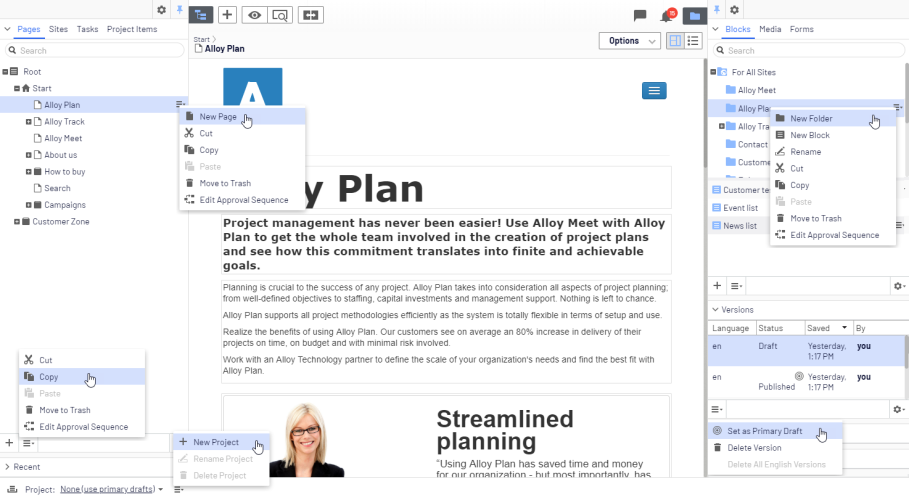 User interface
User interface
The toolbar and the panes in the Optimizely edit view provide easy access to functions when working with content. When entering the edit view, you have the top menu and the toolbar at the top, and adjustable panes to the left and right.
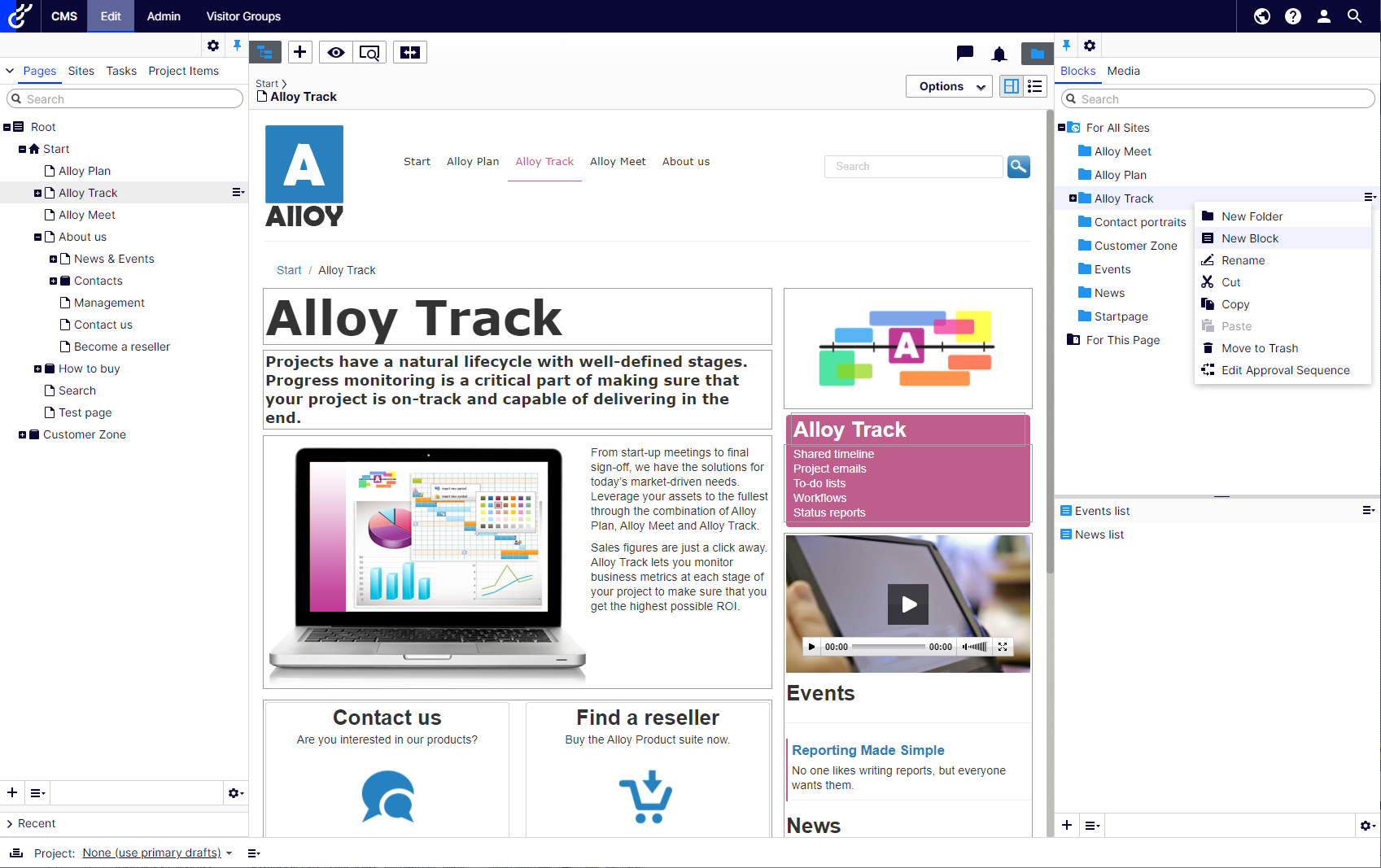
The Optimizely user interface is flexible allowing developers to plug-in customized features when implementing websites. This description refers to Optimizely CMS without further customizations.

The toolbar contains features like preview and view options, and lets you add items such as pages or blocks.

The page information area below the toolbar displays the page name, the path to the page and when it was last autosaved. If it is possible to undo the latest changes you did to the content, there is also an Undo link.

A notification toolbar may be displayed below the toolbar showing information, confirmation, error messages and so on.

General features
- Context-sensitive actions. Some features are only available in certain context. The toolbar (for example) presents relevant actions depending on what you are currently doing, and the add (+) button also offers context-sensitive options.
- Primary actions. Some actions open in a new window, for example, a page delete confirmation. The background is then dimmed, meaning that you must finish the primary action to continue.
- Action feedback and notifications. Successful actions are confirmed by a message in the notification bar. A notification may also appear in case of an error requiring you to take action.
- Drag-and-drop operations. Drag and drop is supported in many areas. For example, you can drag pages, media files and blocks into the rich-text area or content areas, or rearrange the page tree structure using drag-and-drop.
- Tooltips. Hover over a button or field and a short tooltip appears.
- Keyboard commands. Standard keyboard commands are supported in many areas, such as when you move pages in the page tree or in the rich-text editor.
- Search. Supported in many areas to locate, such as pages in the page tree or media in the folder structure.
- Adaptable work environment. Resize and pin the panes depending on what you are currently doing, and add and remove gadgets of your choice for quick access to functionality.
- Support for time zones. Publishing actions in the edit view are done in your local time zone, whereas administrative actions are based on server time.
- Context menus are available in many areas, such as in the panes, the page tree and in item listings. The menu displays different available options depending on where in the interface you are and what you are doing.
Panes
The user interface has a left-hand and a right-hand pane, which can be adjusted and extended with additional gadgets.

|
Pane pin is used for expanding and locking the panes in an open position. |

|
Settings for a pane or a gadget allow you to configure or remove a gadget, or rearrange gadgets in a pane. |
Left-hand navigation pane
Contains the page tree structure (Pages), language branch (Sites) navigation, tasks management (Tasks), and project items (Project Items) by default.
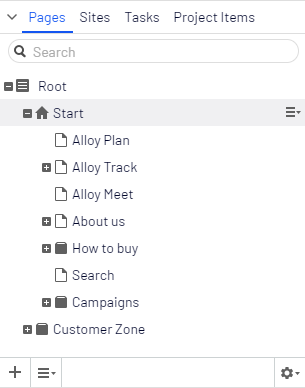
Right-hand assets pane
Contains the Media and Blocks folder structures by default. Drag and drop one or multiple items from the assets pane into the content you are currently working on.
You can also drag and drop multiple items within the assets pane, and delete, cut or copy and paste them, from the context menu or with standard keyboard shortcuts. Any unselected children folders are also moved, copied or deleted.
If you copy and paste multiple folders on different levels, they will be on the same level when pasted.
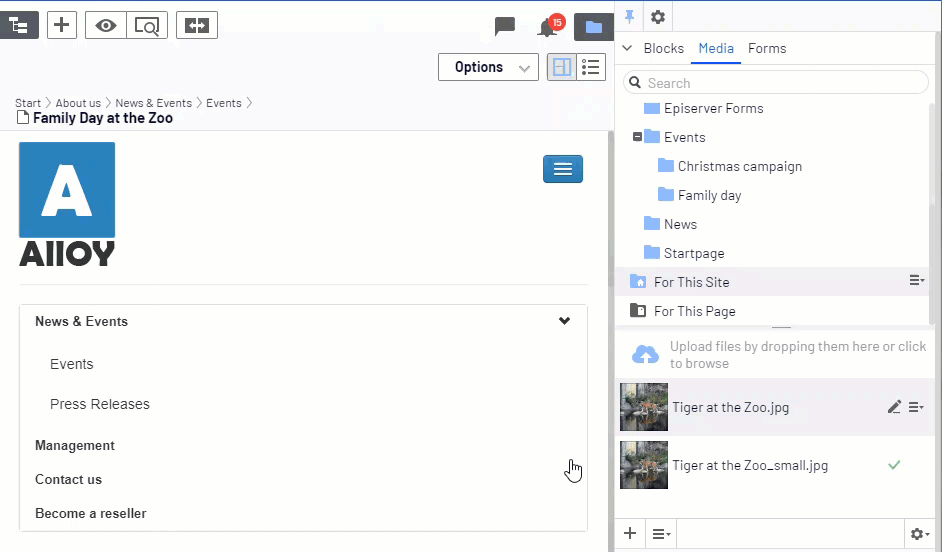
If you have Optimizely Commerce or Optimizely Forms installed, the assets pane also displays the Catalogs and Forms gadgets per default.
Editing
The toolbar on top displays an actions menu with context-sensitive publishing options which vary depending on content status and user access rights. During editing, content status and autosave information are displayed.
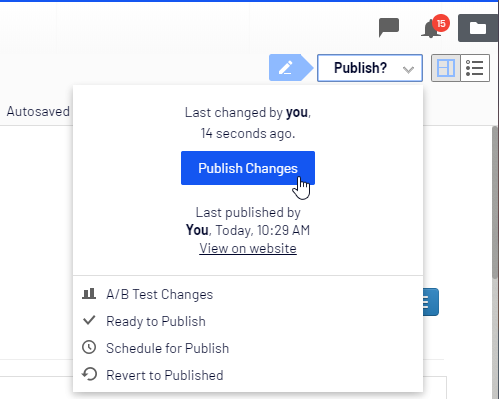
When working with content such as pages and blocks in CMS, or catalog content in Optimizely Commerce, there are two editing views, On-Page Editing and All Properties, with buttons to switch between them.
|
|
On-Page Editing view provides quick access to direct editing of a selection of content properties. |
|
|
All Properties view provides access to all available properties including more advanced ones such as access rights and language settings. |
When editing content properties, these options are common when adding, deleting, or selecting items:
|
|
Click to select (a category, for example). |
|
|
Click to select (an image in a media folder, or a page in the page tree). |
|
|
Click to remove (a category, for example). |
Real-time Updates
Optimizely is by default set up to display project comments and changes to projects in the user interface immediately. If Optimizely experiences problems with the these immediate updates, the following dialog box appears.
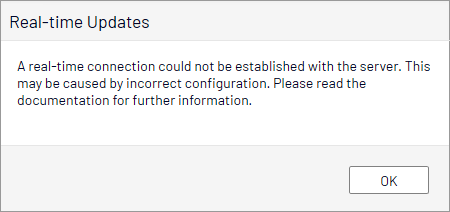
The Real-time Updates dialog box can have two main reasons. It appears because Optimizely has encountered a network problem and cannot connect to the web server, or because your system does not have the WebSocket protocol enabled, which is used for the real-time updates of the user interface.
Network problems
Network problems occur if there is an error in the web server configuration, or if there are problems with your corporate network or the with Internet connection. As long as there is a problem, you are unable to continue working with Optimizely.
Whatever the reason, Optimizely will try to reconnect to the web server. If it still cannot connect after a number of attempts, you get an error message saying: "The server has been unavailable for an extended period of time. Please verify the internet connection and refresh the browser."
Contact your IT department or Internet service provider if the problem persists.
WebSocket support
WebSocket is an Internet protocol used to automatically update the Optimizely user interface.
If you are using the projects feature, the WebSocket protocol is used to check for new or updated comments and project items from other users. As soon as one of your colleagues adds a comment or project item, Optimizely automatically updates your user interface and displays the comment or item (assuming you have the projects interface open).
However, the WebSocket protocol must be enabled for your system by an administrator for the real-time updates to work. If it was not enabled, you can still work with Optimizely and with projects and comments but you need to manually refresh the user interface with the Refresh button to see new comments or items.
Depending on the system configuration when the WebSocket protocol is disabled, you may or may not see the Real-time Updates dialog box.
My settings
Under the top menu > your user name > My settings, you can change some of your account settings. User name and password are usually set in an external system, such as Windows or an SQL database, and cannot be changed in Optimizely in that case.
In the Display Options tab, you find the following settings:
- Personal language. Select your desired user interface language from the drop-down list. This settings affects the language of the user interface, such as texts in buttons and dialog boxes. It does not affect the language of your website.
- Limit touch support. On touch-screen devices, browsers may have difficulties prioritizing between input from the screen and from the computer mouse, which may cause problems such as making it impossible to resize panes using the computer mouse. If you experience problems with Optimizely and the touch screen, enable the Limit touch support feature. This feature prioritizes computer mouse input over touch screen input and enables the computer mouse for interactions such as drag and drop, resizing of panes, and so on.
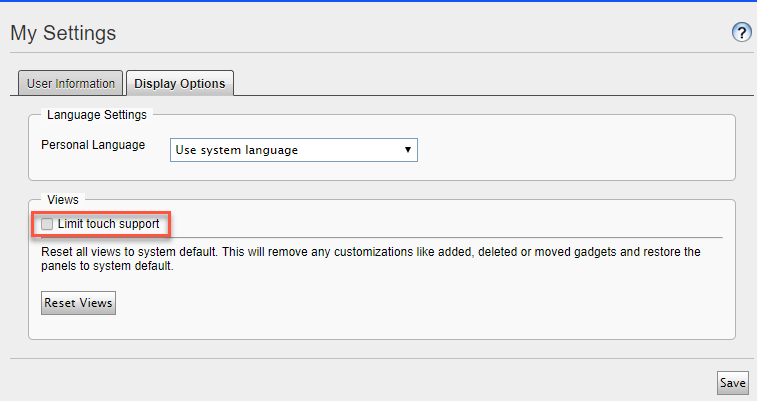
- Reset all views to system default. You can reset your user interface views to the settings. If you have changes to the user interfaces, such as added, moved or deleted gadgets, these changes are undone and the default views are displayed.
Add-ons
An add-on is a plug-in or module, developed by Optimizely or Optimizely partners, to extend the capabilities of Optimizely. A developer (or someone with Access rights) installs most add-ons. See Optimizely World for installation, configuration, and customizing details for each add-on.
When they are installed on the website, you can add some of the add-ons as gadgets to the dashboard or to the navigation or assets panes in edit view.
